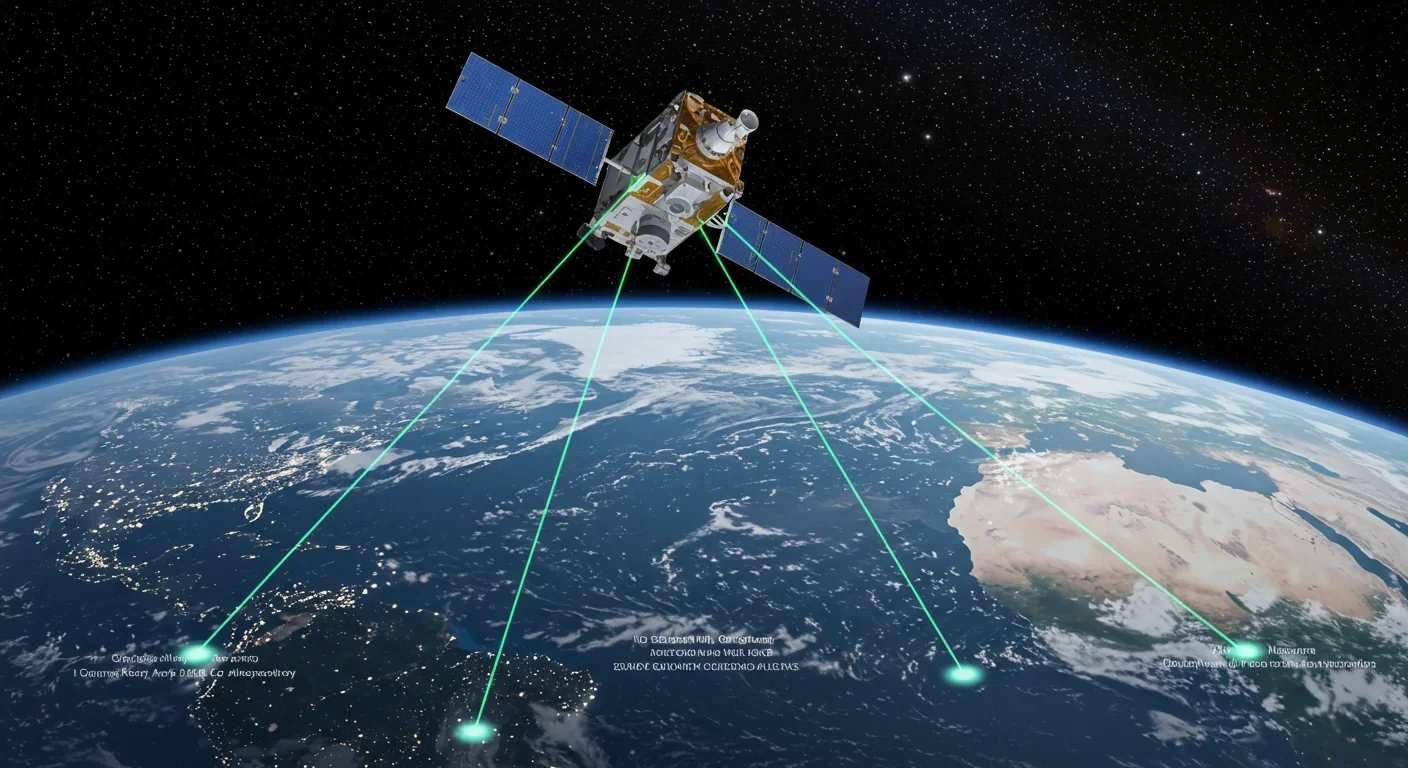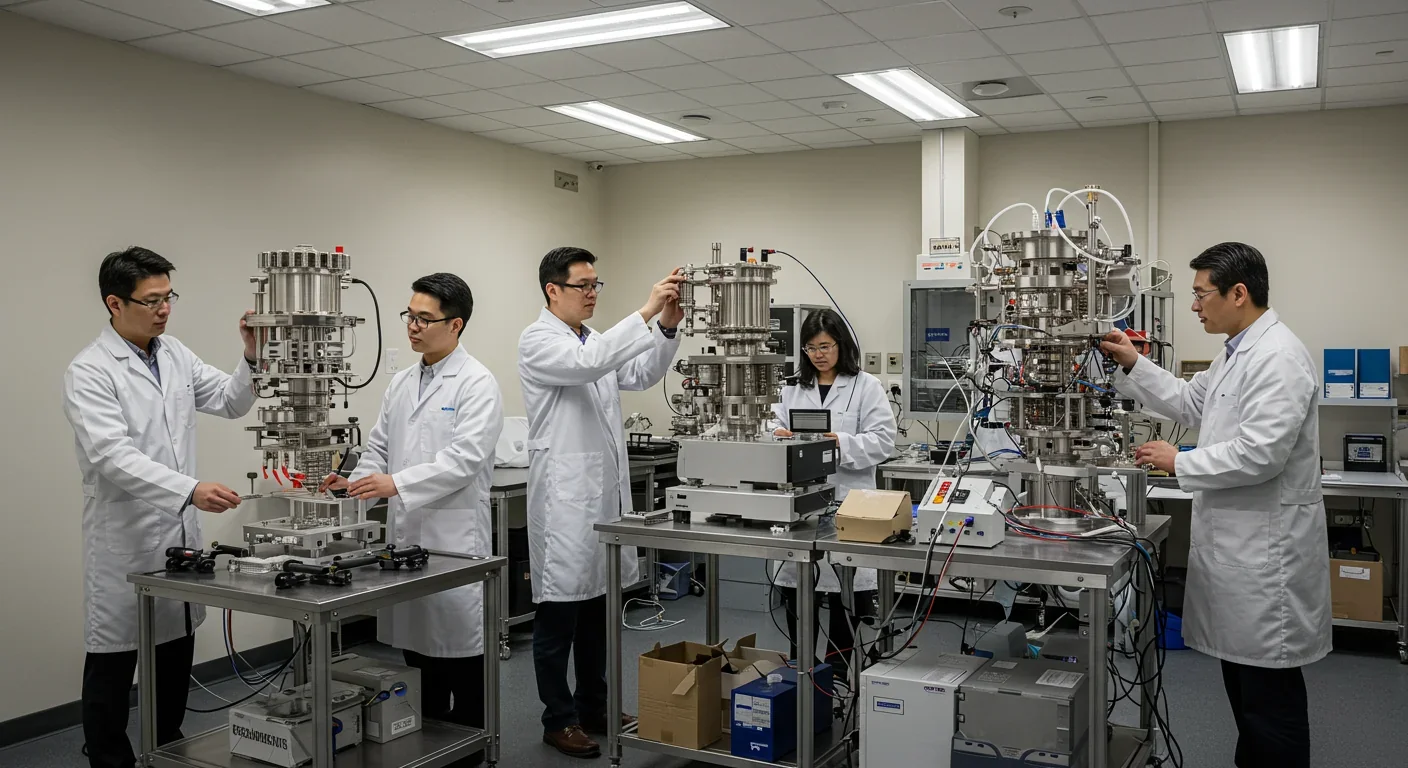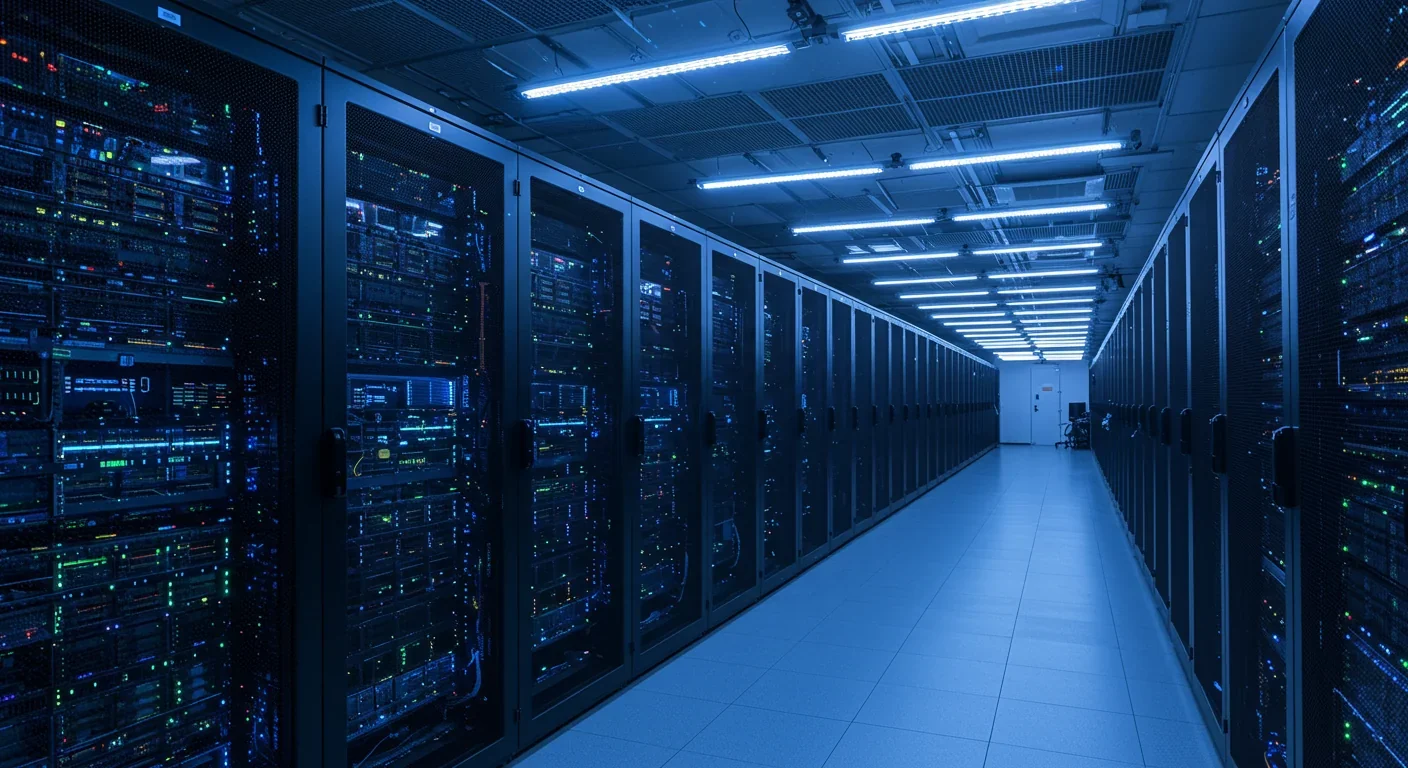Mars Methane Mystery: Hidden Microbes or Geology?

TL;DR: Quantum satellites use entangled photons to create unhackable encryption keys protected by physics itself. China's Micius satellite proved the concept works, and now nations worldwide are racing to build quantum-secure space networks before quantum computers break today's encryption.

By 2033, there's a 31% chance your passwords become worthless. Not stolen, not cracked through brute force, but rendered obsolete by quantum computers powerful enough to shatter every encryption standard we rely on today. This looming threat, dubbed "Q-Day," has cybersecurity experts scrambling for solutions. The answer might be floating 500 kilometers above your head.
China launched the world's first quantum communication satellite in 2016, demonstrating something remarkable: photons entangled at the quantum level can create encryption keys that are fundamentally impossible to hack. Not difficult. Not impractical. Impossible, according to the laws of physics. Now, as quantum satellites multiply and nations race to secure their data against future threats, we're witnessing the birth of an unhackable internet that lives in space.
Traditional encryption relies on mathematical complexity. Your online banking depends on problems so hard to solve that even supercomputers would need centuries to crack them. But quantum computers don't play by those rules. Shor's algorithm, developed in 1994, proved that a sufficiently powerful quantum machine could factor large numbers efficiently, breaking RSA encryption in hours instead of millennia.
Quantum key distribution (QKD) takes a completely different approach. Instead of relying on math problems, it harnesses the strange properties of quantum mechanics itself. When two particles become entangled, measuring one instantly affects the other, no matter how far apart they are. This isn't science fiction, it's verified physics that Einstein famously called "spooky action at a distance."
Here's the crucial part: you can't observe a quantum system without changing it. It's like trying to read a letter that self-destructs the moment you look at it. If someone intercepts entangled photons traveling between a satellite and ground station, the quantum state collapses, and both parties immediately know their connection has been compromised. No secret key is ever transmitted over the network because the key materializes simultaneously at both endpoints through quantum measurements.
This creates a security guarantee that exists outside the realm of computational power. Even if an adversary builds a quantum computer a million times more powerful than anything today, they still can't read messages encrypted with quantum-distributed keys without detection. The universe itself guards the secret.
Making quantum physics work in space is phenomenally difficult. Entangled photons are fragile things. Atmospheric turbulence, distance, and environmental noise all threaten to destroy the delicate quantum states needed for secure communication. Early QKD experiments worked over short distances through fiber optic cables, but signal loss limited practical ranges to a few hundred kilometers.
Satellites offered a solution. In the vacuum of space, photons can travel vast distances without degradation. By placing quantum sources in orbit and beaming entangled photons to ground stations thousands of kilometers apart, researchers could create secure links spanning continents. The technical challenges were immense: tracking fast-moving satellites with sub-microradian precision, maintaining photon entanglement through atmospheric distortion, and generating enough photon pairs to establish usable key rates.
China's Micius satellite, officially named the Quantum Experiments at Space Scale (QUESS), shattered expectations. Launched in August 2016, Micius successfully demonstrated QKD over 1,400 kilometers, linking ground stations in China and Austria. In 2017, it facilitated the first quantum-secured video call between researchers on different continents. These weren't laboratory curiosities; they were practical demonstrations that satellite QKD could work in real operational conditions.
The engineering achievement can't be overstated. The satellite had to generate entangled photon pairs, split them, and beam them to separate ground stations with extraordinary precision. Tracking systems needed to lock onto the satellite as it passed overhead at 7 kilometers per second. Detectors had to register individual photons against the noise of background light. And the quantum correlations had to survive all of this.
Since Micius, the field has accelerated. Singapore's researchers are developing shoebox-sized quantum satellites to replicate Micius's capabilities at lower cost. The European Space Agency has announced plans for quantum communication infrastructure. NASA's Jet Propulsion Laboratory is exploring QKD for deep space missions. What was extraordinary in 2016 is becoming routine.
The operational process is elegant in its simplicity, despite the quantum complexity underneath. A quantum satellite orbiting Earth carries a source that generates pairs of entangled photons. These photon pairs are simultaneously distributed to two ground stations, optical telescopes that can be thousands of kilometers apart.
Both ground stations measure their received photons and record the results. Because the photons were entangled, their measurement outcomes are correlated in specific ways. The stations compare a subset of their measurements over a public channel to verify quantum correlations and check for eavesdropping. If the correlations match predictions and show no signs of interference, they know their link is secure.
The remaining measurements become raw key material. Through classical post-processing including error correction and privacy amplification, both stations derive an identical secret key that was never transmitted through any channel. This key can then be used with conventional encryption algorithms like AES to protect actual data transmissions.
The beauty of this approach is its compatibility with existing infrastructure. Quantum networks can deliver keys to standard routers, VPNs, and encryption devices through established interfaces. Organizations don't need to replace their entire communications stack; they augment it with quantum-generated keys that future-proof it against quantum attacks.

China's early lead in quantum satellites wasn't accidental. The nation identified quantum communications as a strategic priority over a decade ago, investing billions in research and infrastructure. Beyond Micius, China has deployed a 2,000-kilometer terrestrial quantum network connecting Beijing and Shanghai, with plans to extend it globally via satellites. The country already uses quantum communications for sensitive military and financial transmissions.
This head start has prompted other nations to accelerate their programs. The United States, which initially focused more on quantum computing than quantum communications, is now investing heavily in QKD research. The National Quantum Initiative Act allocated substantial funding, and the Department of Defense is exploring quantum networks for secure military communications.
Europe has launched several initiatives, including the European Quantum Communication Infrastructure, which aims to connect member states through a hybrid network of terrestrial fiber and satellite links. Individual nations like the UK, Germany, and France have national quantum technology programs with significant resources dedicated to secure communications.
The stakes extend beyond technological prestige. Control over quantum communication infrastructure could determine which nations can guarantee data security in the post-quantum era. As one analyst noted, quantum technologies represent a "new frontier in global power dynamics," with implications for defense, intelligence, economic competitiveness, and diplomatic leverage.
But cooperation exists alongside competition. The 2017 quantum-secured video call between China and Austria demonstrated that international quantum links are feasible. Scientists globally recognize that a quantum-secure internet would benefit from interoperability and standardization. The tension between national security concerns and the collaborative nature of scientific progress creates a complex landscape where countries simultaneously compete and cooperate.
The applications of quantum-secure satellite communications extend across sectors. Financial institutions, which process trillions in daily transactions, face existential risk from harvest-now-decrypt-later attacks, where adversaries steal encrypted data today to decrypt it once quantum computers mature. Quantum key distribution eliminates this threat, ensuring that financial data remains secure indefinitely.
Government communications, particularly for defense and intelligence agencies, require the highest security levels. Quantum satellites could enable secure coordination between military units, embassies, and command centers without fear of interception. NATO and the European Defence Agency are actively investigating quantum technologies for military applications.
Healthcare systems increasingly rely on digital infrastructure to store sensitive patient records and coordinate treatment. Quantum encryption could protect this data against future breaches, which is crucial given that health information remains valuable decades after collection. Research collaborations involving proprietary data could proceed with greater confidence in data security.
Even commercial applications are emerging. Companies handling intellectual property, trade secrets, or confidential business communications could use quantum-secured channels to prevent corporate espionage. As quantum satellite technology matures and costs decrease, these services may become accessible beyond government and large enterprise customers.
The technology also enables new capabilities. Researchers have demonstrated quantum teleportation of information, which could eventually allow quantum computers in different locations to share quantum states securely. This could enable distributed quantum computing networks with capabilities impossible for isolated machines.
Despite remarkable progress, significant obstacles stand between today's demonstrations and a fully operational quantum internet. Cost is perhaps the most immediate barrier. Developing, launching, and operating quantum satellites requires hundreds of millions of dollars. Ground stations need expensive specialized equipment including precision tracking systems and single-photon detectors. Current quantum communication infrastructure is too expensive to replace classical encryption for most applications.
Technical limitations persist as well. Key generation rates remain relatively low, typically kilobits per second rather than the megabits or gigabits common in classical systems. This is sufficient for distributing encryption keys but far below the bandwidth needed for direct quantum data transmission. Satellite passes are brief, often just minutes at a time, limiting continuous coverage. Weather can disrupt free-space optical links, requiring backup systems.
Environmental noise poses ongoing challenges. Stray photons from sunlight, moonlight, or ground-based light sources can overwhelm detectors, limiting many quantum links to nighttime operation. Researchers are developing better filtering and detection techniques, but photon noise remains a fundamental challenge for space-based QKD.
Standardization and interoperability need work. Different quantum communication systems use varying protocols, wavelengths, and hardware. For a global quantum network to function, devices from different manufacturers and nations must communicate reliably. Organizations like the International Telecommunication Union and European Telecommunications Standards Institute are developing standards, but adoption will take time.
There's also the question of attack sophistication. While QKD is theoretically secure, implementations can have vulnerabilities. Side-channel attacks, hardware Trojans, and denial-of-service tactics could compromise real-world systems even if the underlying quantum protocol remains secure. Security researchers continue probing quantum systems for practical weaknesses.

The trajectory is clear even if the timeline remains uncertain. Quantum satellite technology is advancing from research demonstration toward operational deployment. Commercial ventures are entering the space, with companies like Arqit and others developing quantum encryption services. Governments are investing in national quantum infrastructure, recognizing that quantum security will become critical as quantum computing matures.
The next decade will likely see constellation deployments with multiple quantum satellites providing more continuous coverage. Improved technology should increase key generation rates and reduce costs. Integration with terrestrial quantum networks will extend the reach of satellite links, creating hybrid systems that combine the best of fiber and free-space approaches.
Emerging technologies may expand capabilities further. Quantum repeaters, which could extend the range of quantum communications without trusted intermediate nodes, remain a key research goal. Quantum memories that can store quantum states could enable more flexible network architectures. Advances in quantum error correction might enable more robust systems that tolerate higher noise levels.
The potential extends beyond secure communications. Quantum satellite networks could enable global quantum computing infrastructure, quantum-enhanced sensing systems, and fundamental physics experiments impossible with terrestrial setups. The technology could reshape aerospace applications from navigation to satellite positioning.
The quantum revolution in communications won't happen overnight, but organizations should prepare now. The first step is awareness: understanding that quantum computers will eventually break current encryption and that quantum-safe alternatives exist. Post-quantum cryptography algorithms, which use classical math problems believed resistant to quantum attacks, offer one path forward. Quantum key distribution provides another, complementary approach.
Hybrid systems combining post-quantum algorithms with QKD may offer the most robust defense, protecting against both quantum and classical threats. Organizations should inventory their cryptographic systems, identifying which are most vulnerable and prioritizing migration strategies. Long-lived secrets or data requiring decades of protection deserve special attention.
As quantum satellite services become commercially available, businesses should evaluate their security requirements against the costs and benefits of adoption. Early adopters may gain competitive advantages in security-critical sectors. Industry consortia and standards bodies will play crucial roles in ensuring interoperability and establishing best practices.
For individuals, the quantum transition will be largely invisible. Your bank's security will improve, government services will become harder to compromise, and sensitive health data will gain protection. You probably won't need to do anything differently, any more than you actively manage the encryption protecting your current web browsing.
What makes quantum satellites truly revolutionary isn't just their security. It's the fundamental shift in how we think about trust in digital systems. Classical encryption requires trusting that certain problems are hard to solve. We believe, but can't prove, that factoring large numbers is difficult. That belief could be wrong, as quantum computers may eventually demonstrate.
Quantum key distribution offers something different: security guaranteed by physical law rather than computational assumptions. You don't need to trust that your adversary lacks sufficient computing power. The laws of quantum mechanics ensure that eavesdropping can't go undetected, regardless of the attacker's capabilities.
This represents a profound change in the foundations of digital security. For the first time, we can build communication systems whose security doesn't depend on the limits of technology or computational complexity. Instead, security flows from the fundamental structure of reality itself.
As quantum satellites proliferate and quantum networks expand, this physics-based security will become increasingly accessible. The unhackable space networks being built today may seem exotic, but they're laying groundwork for a future where secure communication is a physical guarantee rather than a mathematical hope. In an age of escalating cyber threats and advancing quantum computers, that guarantee might be exactly what we need.
The quantum future isn't coming. It's already here, orbiting overhead, waiting for the world below to catch up.

Curiosity rover detects mysterious methane spikes on Mars that vanish within hours, defying atmospheric models. Scientists debate whether the source is hidden microbial life or geological processes, while new research reveals UV-activated dust rapidly destroys the gas.

CMA is a selective cellular cleanup system that targets damaged proteins for degradation. As we age, CMA declines—leading to toxic protein accumulation and neurodegeneration. Scientists are developing therapies to restore CMA function and potentially prevent brain diseases.

Intercropping boosts farm yields by 20-50% by growing multiple crops together, using complementary resource use, nitrogen fixation, and pest suppression to build resilience against climate shocks while reducing costs.

Cryptomnesia—unconsciously reproducing ideas you've encountered before while believing them to be original—affects everyone from songwriters to academics. This article explores the neuroscience behind why our brains fail to flag recycled ideas and provides evidence-based strategies to protect your creative integrity.

Cuttlefish pass the marshmallow test by waiting up to 130 seconds for preferred food, demonstrating time perception and self-control with a radically different brain structure. This challenges assumptions about intelligence requiring vertebrate-type brains and suggests consciousness may be more widespread than previously thought.

Epistemic closure has fractured shared reality: algorithmic echo chambers and motivated reasoning trap us in separate information ecosystems where we can't agree on basic facts. This threatens democracy, public health coordination, and collective action on civilizational challenges. Solutions require platform accountability, media literacy, identity-bridging interventions, and cultural commitment to truth over tribalism.

Transformer architectures with self-attention mechanisms have completely replaced static word vectors like Word2Vec in NLP by generating contextual embeddings that adapt to word meaning based on surrounding context, enabling dramatic performance improvements across all language understanding tasks.